|
 | Anglo Saxon History |  | |
| | Landscape - The Great Oak Forest of Andredsweald |
|---|
| |
|---|
Starting point - investigating the hurst snippet
|
|---|
The current translation of 'hurst' derives from the Saxon 'hyrst' which when looked up in the Anglo Saxon Dictionary is
translated as 'A hurst, copse, wood'.
The starting point for this was to investigate the villages/towns that contained the snippet 'hurst', to try to
see what this could mean, if anything.
Normally I would plot these locations onto a Google map to see if there is any obvious logic to these places, and so
carried this out.
The map shown below takes the place names from the free O.S. map data containing about 250,000 places in the U.K. and
plotted all the places containing hurst against their physical locations on a Google relief map.
Please Note:
All the maps shown on this page are derived from Google Maps.
The Domesday plots are derived from the Open Domesday website.
The modern places are derived from the publically available Ordnance Survey Data.
|
Plot of Hursts across the UK ▲
|
|---|

As you can see there appear to be two clusters of places containing the snippet 'hurst' one in the South East of
England, and the other between Nottingham and Liverpool.
| | |
|---|
| My Area - Battle in East Sussex ▲ |
|---|
I live in a small town called Battle in East Sussex, where the 'Battle of Hastings' is claimed to have occurred,
so i will look at my area in a bit more detail.
| | |
|---|
Close up view of the South East of England ▲
|
|---|

As you can see, the majority of these 'hurst's' lie within an area I have marked with a green border.
This is an interesting shape, do we have any other historic information we can use, so lets see if we can plot the
Domesday villages to see if that explains anything.
|
South East of England at Domesday 1086AD ▲
|
|---|
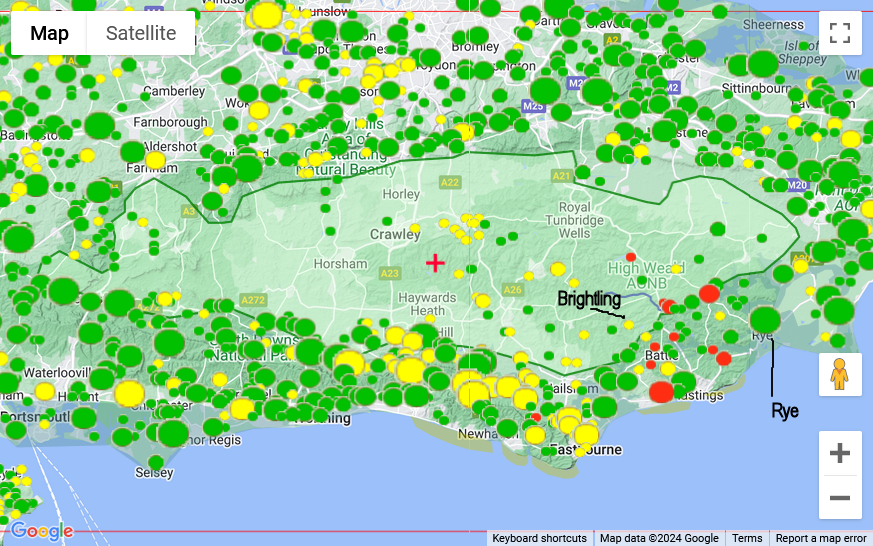
This plot shows all the villages at Domesday and shows very few villages within the green shaded area, and these are
small.
The size of each dot shows the relative size of the population at Domesday, so for Example Domesday Rye had a population
of 187(large green dot) whereas Brightling in the Forest area has 12(small yellow dot).
The Green dots show villages that did not have any damage done by the Norman invasion, the yellow dots show damaged
settlements, and the red ones show settlements that were completely destroyed in 1066AD.
| | I had heard there was a large forest in the area ▲ |
|---|
I had read that there was a large forest in the area whilst reading the Anglo Saxon Chronicles so lets see what can
be found.
| | The Great Oak Forest of Andredsweald ▲ |
|---|
Quote from Wikipedia
The Weald (/ˈwiːld/) is an area of South East England between the parallel chalk escarpments of the North and the
South Downs. It crosses the counties of Hampshire, Surrey, West Sussex, East Sussex, and Kent. It has three separate
parts: the sandstone "High Weald" in the centre; the clay "Low Weald" periphery; and the Greensand Ridge, which
stretches around the north and west of the Weald and includes its highest points. The Weald once was covered with
forest, and its name, Old English in origin, signifies "woodland". The term is still used today, as scattered farms and
villages sometimes refer to the Weald in their names.
|
These are the relevant extracts from the Anglo Saxon Chronicles
AD477. This year Aelle, and his three sons, Cymen, and Wlencing, and Cissa, came to the land of Britain with three
ships, at a place which is named Cymenes-ora, and there slew many Welsh, and some they drove in flight into the wood
that is named Andreds-lea.
755AD This year Cynewulf, with the consent of the West-Saxon council, deprived Sebright, his relative, for
unrighteous deeds, of his kingdom except for Hampshire; which he retained, until he slew the alderman who remained the
longest with him. Then Cynewulf drove him to the forest of Andred, where he remained, until a swain stabbed him at
Pryfetesflodan( fleet), and revenged the alderman,
Cumbra.
AD 892/3. This year went the large army, that we before spoke about, came from a kingdom in the east, westward to
Bologne; and there were shipped; so that they transported themselves over at one time with their horses withal. And they
came up with two hundred and fifty ships into the mouth of the Limne, which is in East-Kent, at the east end of the vast
wood that we call Andred. This wood is in length, east and west, one hundred and twenty miles, or longer, and thirty
miles broad. The river that we before spoke about comes out of the weald. On this river they towed up their ships as far
as the weald(wood). Four miles from the mouth of the river they destroyed a fort within the fen(possibly Burmarsh - Burh
Maersc the marsh fort), whereon sat a few churls, and which was hastily wrought. Soon after this came Hasten up with
eighty ships into the mouth of the Thames, and wrought him there a work at Milton. and the other army went to
Appledore.
So we have a large forest 120 miles long by 30 miles wide covering the area.
It so happens that the green shaded area on our map is about 95 miles long and about 25 miles
wide, so is very close to the recorded size of Andredsweald. We also have to acknowledge that the measurements at the
time would not be as accurate as modern times.
This implies that a settlement name that includes 'hurst' means 'a clearing in the Forest' and not a wood or
copse..
|
The Geology of the area ▲
|
|---|
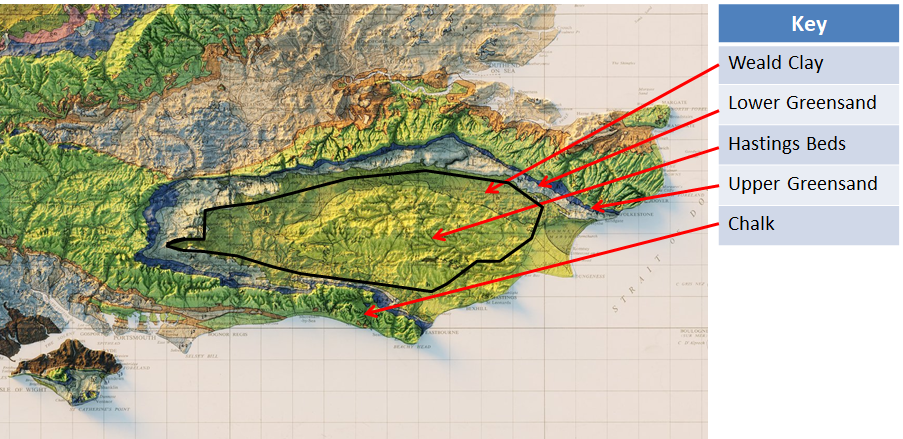
The Iron rich soils of the Hastings Beds provides very good Oak and forest growing land and the Forest shape shown in
black from the Domesday boundary plot seems to reflect the geology of the area.
As you can see the area around Hastings is also covered by the Hastings beds, so it can be assumed that originally the
Forest reached the sea in this area, pre Roman.
It is possible that the original Forest filled the area up to the Upper Greensand boundary.
Let us now plot the settlements containing 'hurst'.
|
Domesday Hurst's 1086AD ▲
|
|---|
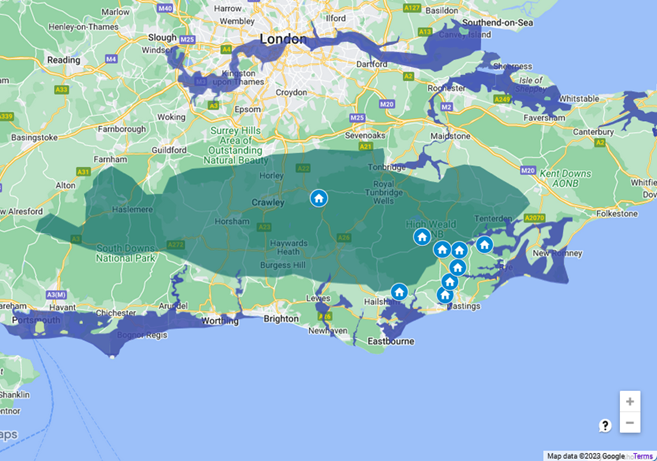
This plot shows just the villages containing the snippet 'hurst' at Domesday.
As you can see there are very few and these are mostly near Pevensey and Hastings which is odd.
| | History and Assumptions ▲ |
|---|
So why are there a few Hursts in Domesday around Hastings?
Perhaps the forest was bigger and that the hursts at Domesday were originally in the Forest.
We now need to make a few assumptions:
- Hurst means ‘a clearing in the Forest’
- The Saxons settled in the Hastings area around 460AD (as the majority of village names in the area are of Saxon
origin)
- The hursts recorded in Domesday were settled in early Saxon times.
- The Romans were extracting iron and making ships from the wood in the forest.
- The foundations of the Roman fort of Anderida(Pevensey) used oak and we have calculated that a square km of forest
would be needed to provide the oak required.
- The Romans and Saxons built their ships from oak.
- The high tide level was approx 4.5 metres higher in Roman times.
- The Saxons continued the Roman ship building in the Hastings area.
- The time between the early Saxon times of about 460AD to the Domesday book of 1086AD are 626 years.
If the above is true then the rate of Forest removal of the Forest in the Hastings area was significantly higher than
other areas in Kent and Sussex, or there would have more hursts recorded in Domesday in other areas.
So if the Forest is being felled continuously for 650 years to smelt iron and build ships then this would make the area
of Forest removed quite significant and make the Forest much larger in Roman times.
|
Forest expanded to include the Hursts at Domesday ▲
|
|---|
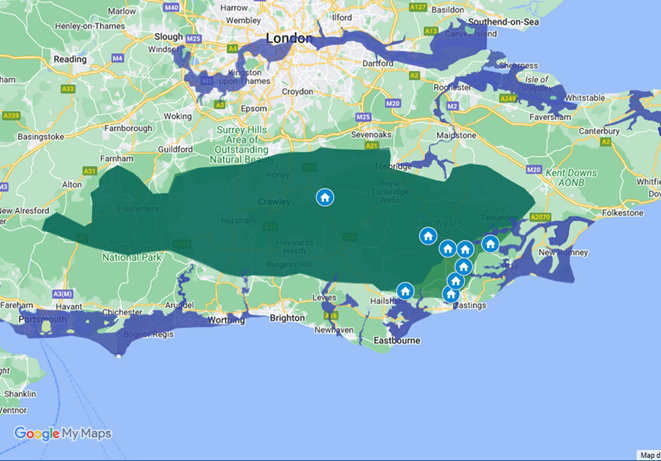
This plot shows just the villages containing the snippet 'hurst' at Domesday.
If we now enclose the areas of the Domesday hursts within the Forest then we now show the approximate Forest boundary
about 460AD when the Saxons settled, and at this time it was known by its Roman name of Silva-Anderida ( this could be
translated from the Latin to mean the ‘entry point to the Forest’ ).
Pevensey Castle was known as Anderida (possibly ‘the entry point’) by the Romans.
|
Hursts prior to the Roman Invasion ▲
|
|---|
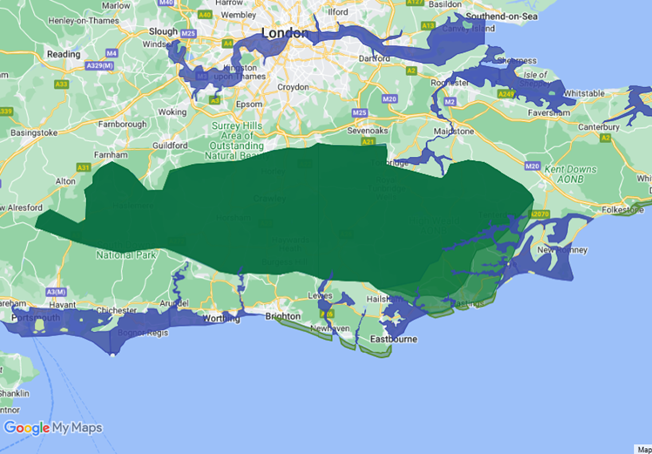
This plot shows the extent of the Forest before the Romans and Saxons started removing the oak for shipbuilding and
iron smelting.
| | The Romans called the forest Silva Anderida ▲ |
|---|
The Romans called the Forest 'Silva Anderida'.
From the Latin 'Silva' translates as 'the forest', 'Anderi' means 'to enter' and 'da'
means 'give'.
So Anderida means 'to give entrance' or 'The entrance' and Silva means 'the Forest', so the Roman fort at
Pevensey(Anderida) meant 'to give entrance', and 'Silva Anderida' means 'the entrance to the Forest'.
| | Roman traces in the Area ▲ |
|---|
The Forest was being felled for fuel for the bloomeries and timber for shipbuilding, which would take place near the
rivers and estuaries as these would provide easy routes to transport iron and oak from the area.
The sea would have reached the forest at Ashburnham behind the fort of Anderida, it would also have reached the sea in
the Filsham valley at Hastings, the river Limen(Rother) and finally the Brede valley so this is where the main
extraction would take place.
The major Roman ironworks were in the Brede valley so that area would be using the timber for fuel, and not for
shipbuilding.
The Rother valley being quite long would have been used for ironworking at Bardown near Stonegate, and shipbuilding near
Bodiam.
This would leave the Pevensey area as the major shipbuilding area, with the Filsham valley as a secondary site.
|
The impenetrable forest ▲
|
|---|
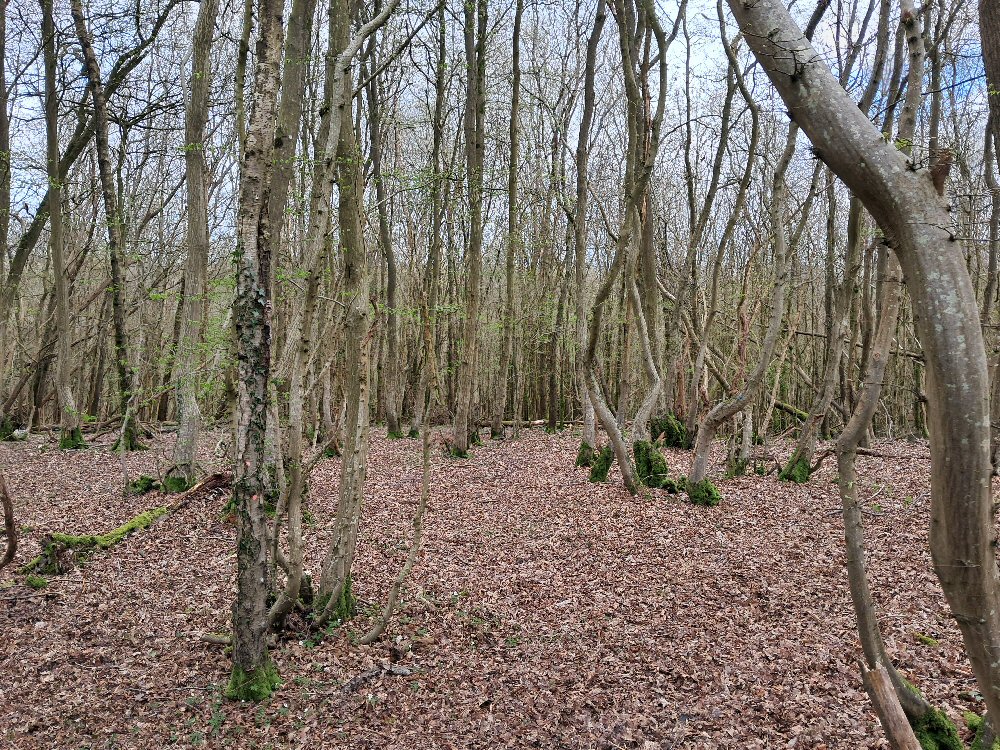 The image to the left shows the current woodland around the Battle area, and shows how dense the trees are, this would
make it very difficult to take horses through the forest.
The image to the left shows the current woodland around the Battle area, and shows how dense the trees are, this would
make it very difficult to take horses through the forest.
The Forest was looked on as being impassible except where the old Ridgeway's or Roman roads passed through, unless you
lived in the Forest.
This would have made it very difficult to leave the area by road, and by the same token, the local forest would provide
excellent timber to build ships, to sail away from the area.
| | |
|---|
| Conclusion ▲ |
|---|
The great Forest of Andredsweald appears to be in the area surrounded by the Domesday
Villages.
The Romans started felling the Forest to build ships and smelt iron.
The Saxons of Hastings continued felling the trees to build ships and houses till the Normans arrived.
The Domesday Book 1086AD gives us the basis for the discovery of the Forest, and also implies the extent of the Forest
back to 460AD.
The displaced Saxons from the Battle of Hastings started felling the Forest interior to create the hursts.
Shipbuilding continued in the area until at least the 1600's especially in the Rother valley.
As the forest provided extremely durable oak and a significant number of place names in the area imply shipyards, it is
very likely that Pevensey Castle(Anderida) became the fleet base for Classis Britannica after Boulogne was taken in
293AD primarily because the main shipyards were here.
| | Recommended Reading ▲ |
|---|
Recommended
Books
(these are books I use for reference and link to Amazon pages) |
|---|
|
|
| | | |
| (As an Amazon Associate, I may earn from qualifying purchases) |
|
|
|
|
|
| |
|
|
Local Interest
Just click an image |
|
|
|
|
|
|
|
|
|
|
|
|
| |
|
|